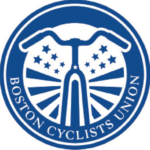Comm Ave cycletrack serves as kickoff for Vision Zero in Boston
“We had a couple bike fatalities last year and seven pedestrian deaths, we can do [all modes of transportation] better,” said Walsh. Vision Zero in Boston will begin with extending the crash data work done with bikes to pedestrians, and identifying hot spots. The task force will seek to create rapid response improvements and create “residential slow zones.”
Along with the Boston Cyclists Union and WalkBoston, the Boston Police Department, the Public Works Department, the Boston Public Health Commission, and Boston Emergency Medical Services will be involved in the task force–convening roughly the same group that has been working on the Health Commission’s Crash Data Task Force for over 2 years.
In other cities such as New York, San Francisco and Portland Oregon, Vision Zero has expanded to include a much broader set of policy changes at various city departments. The likelihood is that as the task force studies the problem of road injuries and fatalities, more initiatives will arise.
The Commonwealth Avenue project itself is a major step forward for Vision Zero, and the mayor defended the plan with confidence.
“Their purchase[s] may be smaller, but they’re more frequent,” he said of pedestrians and cyclists–an oft cited fact in before-and-after studies of cycletracks and other facilities that typically increase local business revenues.
 A rendering of one of the protected intersections planned for Comm Ave. |
In particular the protected intersection design in the Comm Ave planis rather new in the U.S., having only been installed in a suburban area in Austin Texas so far. NACTO has been holding special design charrettes with Boston and other cities who are working to implement it. The design helps reduce the common “right hook” crash type by creating more visibility between cars and bikes, and will likely change the way cycletracks are built in cities around the country.
During door-to-door canvasing by the Bike Union and local advocates Galen Mook and Matt Danish, the business community expressed support for the plan. However, in this morning’s Boston Herald, City Councillor Mike Flaherty criticized it.
“At a time when we just overspent tens of millions on snow removal and the administration is talking about the need to close five schools, someone comes up with the idea to remove 73 parking meters from the streets of Boston, meters that could generate up to $341,000 a year,” Flaherty said to the Herald. “I want to know who did that cost-benefit analysis.”
Talking to Councillor Flaherty today, the Bike Union confirmed his support for the safety improvements to the street. His priority is to find a way to replace the $341,000 in lost revenue, and his comments were made last night. This morning the Mayor announced that the city will be replacing all of Boston’s traditional parking meters with smart meters-which typically raise parking revenue by 33 percent where they are implemented.
The two announcements coupled with Mayor Walsh’s first-in-the-nation ordinance on truck sideguards are putting Boston on the map as a leader on bike safety on the national level. A large part is due to your continued support of the work the Boston Cyclists Union is engaged in every day. If you appreciate our work, please donate or join now.

